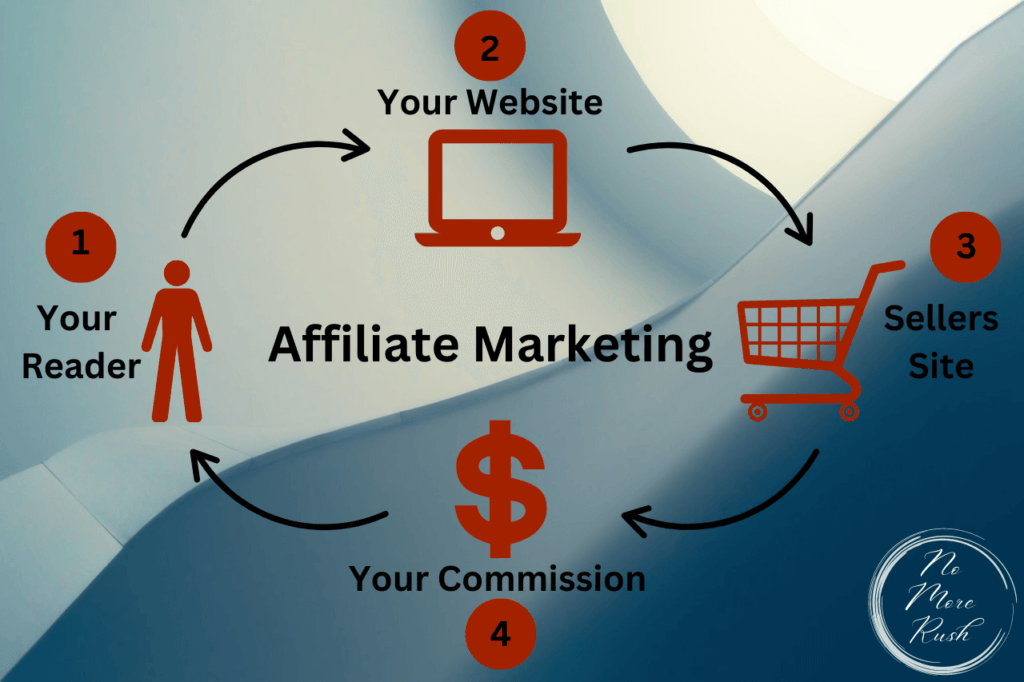So you want to start a blog and monetise it but you’re not sure where to start. Well, affiliate marketing is one such way to do that. But if you’re completely new to the affiliate marketing world then you’re probably wondering, what is affiliate marketing and how to start as a beginner.
The basic concept itself is pretty straightforward so let’s have a look at what it is and how to do it.
What is Affiliate Marketing
Affiliate marketing is essentially when you promote someone else’s product through your own content and you get paid a commission anytime a reader makes a purchase after clicking through to their product site from yours.

It’s one of the most popular ways to monetise a website and the basic process looks something like this.
- Choose a niche (here’s how to choose a niche if you’re stuck)
- Create a website
- Write lots of content including product reviews
- Sign up for affiliate programs
- Add affiliate links to your reviews
- Earn commission if a sale is made after your affiliate link is clicked
As much as affiliate marketing may seem easy, it’s much more complex than my brief bullet point list above and it’s also a lot more work than you might imagine.
You’ll need to have traffic coming to your website to see any of your affiliate marketing efforts pay off because no traffic equals no clicks equals no commission but that’s a whole other ball game.
For now, we’ll just look at the basics of what affiliate marketing is and how to do it. If you do want to learn more about affiliate marketing then you can check out this post I wrote about the training platform that thought me everything I know.
How Does Affiliate Marketing Work
To break it down step by step, I’ll use one of my other sites as an example, and it’s a skincare site.
Normally, if you already know that affiliate marketing is going to be the route you’ll take for monetising your website, you would usually start looking at affiliate programs pretty early on in the game.

In the case of my skincare site, I looked for affiliate programs for popular skincare brands like Olay, Clinique, etc, as well as popular online retailers like Sephora and even Amazon.
To search for affiliate programs, you simply need to do a google search for the company/brand name you want to use followed by the words “affiliate program” and that should bring up numerous results.
Some may be independent in-house affiliate programs whilst others may use an affiliate network but essentially it doesn’t really make a difference as they both work exactly the same way (more on that further down).
Getting Signed Up To Affiliate Programs
Once you’ve found the affiliate programs you want to join and use (don’t worry, most are free to join), you will need to sign up for them and wait to be accepted.

Once accepted, you’ll be given a unique affiliate ID and you’ll be able to use their links (which will include your affiliate ID) within your content.
Some affiliate programs will accept you immediately while others may have certain joining stipulations like how much traffic your site gets for example. Most are easy enough to join though even for a complete beginner with a relatively new website.
It is worth noting that not every company/brand will have its own affiliate program. Because of this, it’s not a bad idea to also sign up for affiliate programs of large online retailers that sell the types of products you’re likely to review.
At least this way, if the company/brand doesn’t have its own affiliate program, you’ll always have somewhere else to send your readers to buy the products you’re reviewing even if it isn’t directly to the brand’s website.
How to Use Your Affiliate Links
So, let’s say I’m using a new facial device and I want to write a review on it for my website and monetise that review with affiliate links.
For argument’s sake let’s say it’s a well-known brand like Foreo and it’s their UFO mask device. Once I’ve written that review, the next thing I would do is sign in to the Foreo affiliate program (or find it and sign up if I haven’t already) and look for links for that particular product.
If Foreo didn’t have its own affiliate program, then I’d go to the program of one of my larger online retailers like Sephora or Amazon instead and look for the links there.
Once I’ve found the links I need, I would copy and paste them within my review, usually by using the product name text as the link just like the image below.

You can also get image links too or if you really want, you can get banners that you can add to your review post or even to your sidebar widgets like the next image below.

Now, anytime a reader clicks on any of those links including the banners, it will take them to the product page of the website selling it.
If they then proceed to purchase that item (or any other item on that site) within a specific timeframe (cookie duration – more on that in a moment), I’ll receive a commission for that sale.
Think of it this way, they’re paying you a commission when they get a sale because you were the one that sent that buyer to that product on their site.
Sometimes Being Last Is Better
As long as my link is the last one clicked before the purchase, I’ll be the affiliate that gets the commission on that sale.
However, if the reader leaves the product site and continues to do more research, read more reviews and eventually clicks on someone else’s affiliate link after mine, they’ll get the commission instead.

It’s the one and only time in life when you want to be the last one picked.
Every affiliate also gets their own ID when they join a program and this ID is automatically built into any links, banners, etc they copy across to their website. This is what the affiliate program uses to identify them from all their other affiliates.
So when someone clicks on an affiliate link and then makes a purchase, the program can identify whose affiliate link it was and pay them the commission accordingly.
What Kind of Commission Can You Expect?
Depending on what programs you join, the commission rates can vary vastly from one program to another so you’ll need to check each one to see which ones offer better rates than others.
Some will offer fairly low rates of as little as 1% to 2% whilst others can offer 50% or more for each sale especially those in the digital space.

In the example I used above, I could have used either Foreo’s affiliate program, Sephora’s or even Amazon’s but in this particular case, Foreo paid the highest commission out of the three so of course, I choose Foreo’s.
They also happened to have the longest cookie duration too so it’s always worth comparing which program works out best for you.
Recurring Commissions
There are also programs that offer a set fee for each sale rather than a percentage and depending on the niche you’re in, there are many that offer recurring commissions.
Think of companies that charge their customers a monthly/yearly fee. These are the ones likely to pay a recurring commission every month/year that a customer you’ve sent them remains signed up.
There is usually a payment threshold though with all affiliate programs/networks so you won’t get paid anything until you’ve earned a certain amount in commissions within a month period.

This can vary depending on the program/networks and typically ranges from $25/£25 to $100/£100 give or take depending on the currency you’ve chosen.
Don’t worry though if you don’t reach the payout threshold on any given month before the payout date because your earnings will always carry forward to the next month.
And they will continue to do so until you reach the payout threshold so you’ll never lose any of the commissions you’ve earned. They’ll just continue to build up until you’ve earned enough to receive your payout.
What is Cookie Duration?
This is basically how long you have to get a commission from the time the reader clicks on your link to the time they make a purchase and check out.
In other words, if the program you’re using only has a 24-hour cookie duration then you’ll only get a commission if someone clicks on your link and makes a purchase within 24 hours of that click.

Once the 24 hours are up, your commission window is closed and that reader’s click is no longer trackable so if they make a purchase after that time, you get zilch, nada, diddly squat.
Much like the commission structure, cookie duration can also vary from program to program with some offering just 24 hours to others offering 30, 60 or even 90 days.
There are also a small number of programs that offer lifetime cookies so regardless of how long it takes for the person who clicked your link to make a purchase, you’ll still get a commission even if it’s a year later (that is, as long as they haven’t clicked anyone else’s affiliate link in the meantime).
What are Affiliate Networks?
Affiliate networks are basically a platform where lots of different affiliate programs are available from lots of different companies/brands all in one place.
They are essentially a third party that deals with all the tracking, reporting and payouts between the affiliate program and the affiliate marketer. They’re usually pretty large and may deal with hundreds or even thousands of affiliate programs (and their affiliates) within their network.

So, essentially you would join an affiliate network and from there, you can peruse all the different affiliate programs available for your niche and join as many of them as you want. Here are just a few examples of some of the more popular ones:
- Rakuten Advertising (Check out my full tutorial on how to join and use the platform)
- CJ Affiliate
- Awin
- FlexOffers
- ShareASale
- Pepperjam
- ClickBank
The handiest thing about these networks is that all your links, reports, banners, etc are all within that one platform for all of the programs you’ve joined through them.
It also means that all your commissions are combined together and paid out together through the network in one lump sum rather than lots of different payments coming from lots of different programs individually.
What are In-House Affiliate Programs?
In-house Affiliate programs are where a company runs its own affiliate program independently without the need of an affiliate network. Amazon would be the best example of this as they run and control every aspect of their program without relying on a third party.

You’ll actually often hear the words program and network used interchangeably when it comes to Amazon but then again it is one of the biggest affiliate programs out there.
From an affiliate marketer’s point of view, both an in-house affiliate program and an affiliate network work in the exact same way. You sign up, get accepted, get access to affiliate links, images, banners, etc and get paid a commission for every sale through those links.
I use several in-house affiliate programs as well as several affiliate networks too. In fact, I use almost all of the networks I’ve mentioned above plus numerous others. And inside my affiliate networks, I could have 20+ programs within each one if not more.
So if you’re planning on getting into the affiliate marketing world, I strongly suggest that you set up an Excel or Google sheet. You’re going to need one to list all the networks and programs you’ve signed up for because trust me, it’s always way more than just one!
Always Include an Affiliate Disclosure
An extremely important thing when it comes to affiliate marketing is to ensure that you have an affiliate disclosure on your site.
You’ve probably heard the stories of influencers getting themselves in trouble for not disclosing their affiliate relationship with the brands they’re promoting so this is something you definitely don’t want to overlook.

A quick Google search for affiliate disclosures should bring up plenty of results including templates and guides on how to write them and where to put them.
If you need some inspiration, you can check out the top of this post for my short top-of-post disclosure. From there you can also click on the link to see my full disclosure page or alternatively, you’ll find it at the bottom of the page in the footer if that helps.
I also have an easy how-to post on how I created and added my short top-of-page disclosure automatically to every post that needed it on my site if you’d like to check that out.
Don’t Forget About Amazon’s Disclosure
Also, if you’re using Amazon as well, they will have a different disclosure that you will also need to use (you’ll notice it in both my short and full disclosure).
As I mentioned at the beginning of this post, there is a lot more to affiliate marketing but for a complete beginner, these are the basic steps to get you up and rolling.
So, if you love writing about the things that interest you, then why not monetise them in the process? There are several other ways to monetise your site but affiliate marketing is an excellent place to start.
Are you just starting out in the affiliate marketing world? If you have a question or just want to share an affiliate marketing story, please feel free to leave them in the comments below.

You May Also Like
- How To Display Recent Posts With Thumbnails In WordPress
- How To Add An Affiliate Disclosure To Your Posts
- What Is Wealthy Affiliate – Everything You Need To Know





I like articles that help people start affiliate marketing. So if you’re posting more content like this I’ll definitely be reading more of your posts. I truly believe that a lot of people can be successful if they just knew about affiliate marketing and what it actually is. Keep it up with the content.
Thanks, KD
I’m glad you enjoyed the post.
My personal experience and opinion about this topic is that it is important to disclose your affiliate relationship and follow ethical and legal guidelines for affiliate marketing. It is also important to note that success in affiliate marketing depends on various factors such as audience engagement, product quality, and marketing strategy.
Absolutely! I couldn’t agree more. Disclosing your affiliate relationship is not only ethical but also builds trust with your audience. Being transparent about your partnerships is so important. It’s an essential practice to maintain credibility and authenticity in affiliate marketing.
And you’re spot on about success factors! Success in affiliate marketing doesn’t happen overnight. It requires consistent efforts to engage your audience, including creating content that resonates with them and promoting high-quality products/services that genuinely benefit them.
Developing effective marketing strategies are a key element to thrive in the affiliate marketing world. You have to keep learning and adapting, and over time, you’ll see positive results in your affiliate journey.